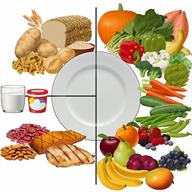ThisisPatientEngagementcontent
DASH Eating Plan
Learn more about our Patient Engagement products now! Turn your patients into active participants in their healthcare by giving them easy access to the same evidence-based information you trust – but delivered in an easy-to-understand format.
Reading food labels
Shopping
Cooking
Meal planning

Lifestyle
General information
Fruits
All fresh, dried, or frozen fruit. Canned fruits that are in their natural juice and do not have sugar added to them.
Vegetables
Fresh or frozen vegetables that are raw, steamed, roasted, or grilled. Low-sodium or reduced-sodium tomato and vegetable juice. Low-sodium or reduced-sodium tomato sauce and tomato paste. Low-sodium or reduced-sodium canned vegetables.
Grains
Whole-grain or whole-wheat bread. Whole-grain or whole-wheat pasta. Brown rice. Oatmeal. Quinoa. Bulgur. Whole-grain and low-sodium cereals. Pita bread. Low-fat, low-sodium crackers. Whole-wheat flour tortillas.
Meats and other proteins
Skinless chicken or turkey. Ground chicken or turkey. Pork with fat trimmed off. Fish and seafood. Egg whites. Dried beans, peas, or lentils. Unsalted nuts, nut butters, and seeds. Unsalted canned beans. Lean cuts of beef with fat trimmed off. Low-sodium, lean precooked or cured meat, such as sausages or meat loaves.
Dairy
Low-fat (1%) or fat-free (skim) milk. Reduced-fat, low-fat, or fat-free cheeses. Nonfat, low-sodium ricotta or cottage cheese. Low-fat or nonfat yogurt. Low-fat, low-sodium cheese.
Fats and oils
Soft margarine without trans fats. Vegetable oil. Reduced-fat, low-fat, or light mayonnaise and salad dressings (reduced-sodium). Canola, safflower, olive, avocado, soybean, and sunflower oils. Avocado.
Seasonings and condiments
Herbs. Spices. Seasoning mixes without salt.
Other foods
Unsalted popcorn and pretzels. Fat-free sweets.
The items listed above may not be all the foods and drinks you can have. Talk to a dietitian to learn more.
Fruits
Canned fruit in a light or heavy syrup. Fried fruit. Fruit in cream or butter sauce.
Vegetables
Creamed or fried vegetables. Vegetables in a cheese sauce. Regular canned vegetables that are not marked as low-sodium or reduced-sodium. Regular canned tomato sauce and paste that are not marked as low-sodium or reduced-sodium. Regular tomato and vegetable juices that are not marked as low-sodium or reduced-sodium. Pickles. Olives.
Grains
Baked goods made with fat, such as croissants, muffins, or some breads. Dry pasta or rice meal packs.
Meats and other proteins
Fatty cuts of meat. Ribs. Fried meat. Bacon. Bologna, salami, and other precooked or cured meats, such as sausages or meat loaves, that are not lean and low in sodium. Fat from the back of a pig (fatback). Bratwurst. Salted nuts and seeds. Canned beans with added salt. Canned or smoked fish. Whole eggs or egg yolks. Chicken or turkey with skin.
Dairy
Whole or 2% milk, cream, and half-and-half. Whole or full-fat cream cheese. Whole-fat or sweetened yogurt. Full-fat cheese. Nondairy creamers. Whipped toppings. Processed cheese and cheese spreads.
Fats and oils
Butter. Stick margarine. Lard. Shortening. Ghee. Bacon fat. Tropical oils, such as coconut, palm kernel, or palm oil.
Seasonings and condiments
Onion salt, garlic salt, seasoned salt, table salt, and sea salt. Worcestershire sauce. Tartar sauce. Barbecue sauce. Teriyaki sauce. Soy sauce, including reduced-sodium soy sauce. Steak sauce. Canned and packaged gravies. Fish sauce. Oyster sauce. Cocktail sauce. Store-bought horseradish. Ketchup. Mustard. Meat flavorings and tenderizers. Bouillon cubes. Hot sauces. Pre-made or packaged marinades. Pre-made or packaged taco seasonings. Relishes. Regular salad dressings.
Other foods
Salted popcorn and pretzels.
The items listed above may not be all the foods and drinks you should avoid. Talk to a dietitian to learn more.
This information is not intended to replace advice given to you by your health care provider. Make sure you discuss any questions you have with your health care provider.
Cookies are used by this site. To decline or learn more, visit our cookie notice.
Copyright © 2025 Elsevier, its licensors, and contributors. All rights are reserved, including those for text and data mining, AI training, and similar technologies.